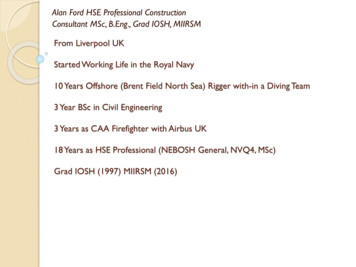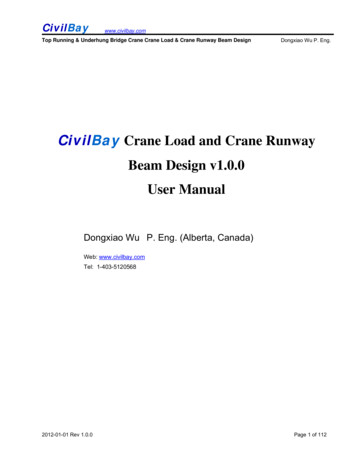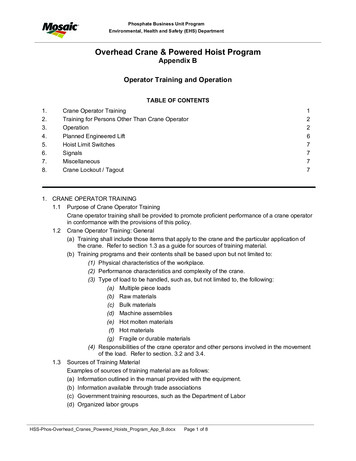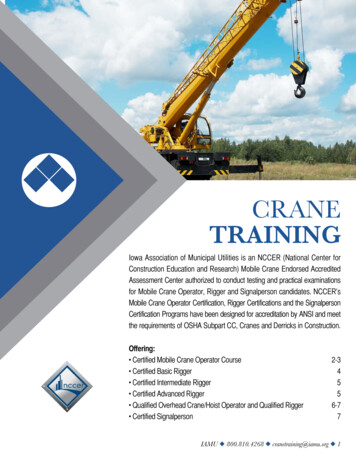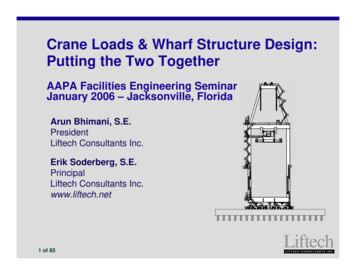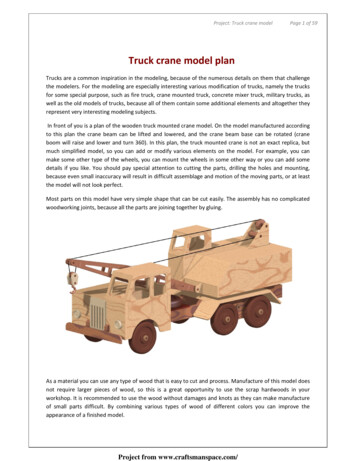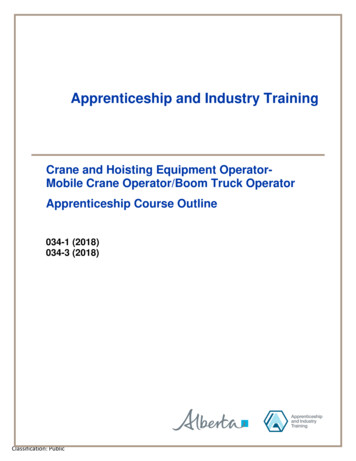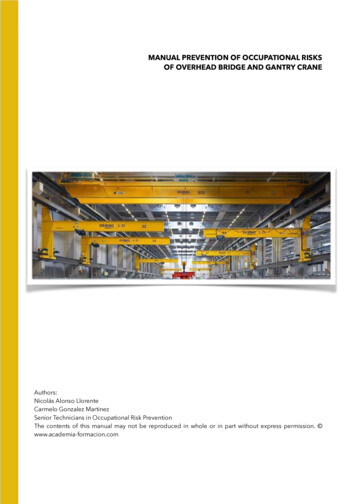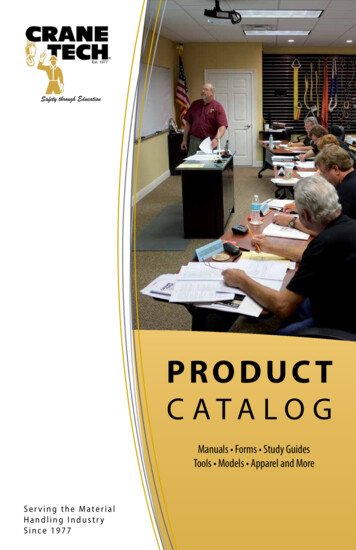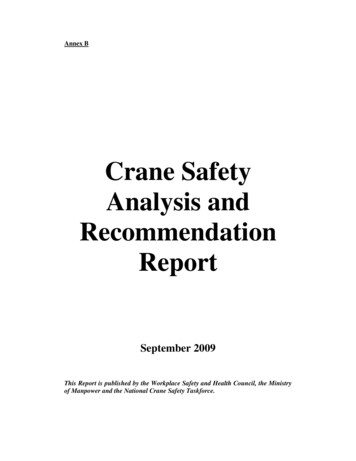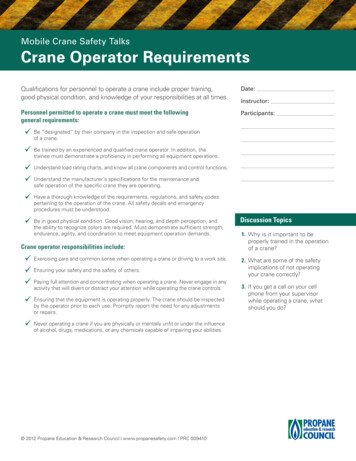
Transcription
Mobile Crane Safety TalksCrane Operator RequirementsQualifications for personnel to operate a crane include proper training,good physical condition, and knowledge of your responsibilities at all times.Date:Personnel permitted to operate a crane must meet the followinggeneral requirements:Participants:Instructor:99Be “designated” by their company in the inspection and safe operationof a crane.99Be trained by an experienced and qualified crane operator. In addition, thetrainee must demonstrate a proficiency in performing all equipment operations.99Understand load rating charts, and know all crane components and control functions.99Understand the manufacturer’s specifications for the maintenance andsafe operation of the specific crane they are operating.99Have a thorough knowledge of the requirements, regulations, and safety codespertaining to the operation of the crane. All safety decals and emergencyprocedures must be understood.99Be in good physical condition. Good vision, hearing, and depth perception, andthe ability to recognize colors are required. Must demonstrate sufficient strength,endurance, agility, and coordination to meet equipment operation demands.Crane operator responsibilities include:99Exercising care and common sense when operating a crane or driving to a work site.99Ensuring your safety and the safety of others.99Paying full attention and concentrating when operating a crane. Never engage in anyactivity that will divert or distract your attention while operating the crane controls.99Ensuring that the equipment is operating properly. The crane should be inspectedby the operator prior to each use. Promptly report the need for any adjustmentsor repairs.99Never operating a crane if you are physically or mentally unfit or under the influenceof alcohol, drugs, medications, or any chemicals capable of impairing your abilities. 2012 Propane Education & Research Council www.propanesafety.com PRC 009410Discussion Topics1. Why is it important to beproperly trained in the operationof a crane?2. What are some of the safetyimplications of not operatingyour crane correctly?3. If you get a call on your cellphone from your supervisorwhile operating a crane, whatshould you do?
Mobile Crane Safety TalksCrane Set-UpCrane set-up can begin after a complete site assessment has beenconducted and all above- and below-ground obstacles and hazards havebeen located. When entering the job site, make sure you maintain asafe clearance from all power lines and obstacles as you proceed toyour final set-up destination.Date:Instructor:Participants:When the set-up location is reached:99Make sure you take into consideration wind, weather, power lines, undergroundhazards, and other factors. Be sure to consider any potential swaying of powerlines caused by wind.99Position the crane as close as possible to the job on a firm, dry, and level surface.Set the parking brake. Exit the vehicle by using three points of contact. Placewheel chocks in accordance with your company’s policy.99Deploy stabilizers or outriggers until they are fully extended. Never position thestabilizers near sharp drop-offs or areas of unstable ground. All personnel shouldbe kept clear of the stabilizers during the deployment process to prevent injuries.99Use hardwood pads or mats to help disperse the weight of the crane if needed.Discussion Topics99The stabilizers should lift the vehicle enough to take the pressure off the suspension1. Why is it important to considerwind and other weatherconditions when you set-upyour crane?If stabilizers or outriggers bury themselves in soft surfaces, do not perform thelift until a stable location is found.system. Never lift the vehicle so high that the wheels lose contact with the ground.99Check the crane’s level. The crane and vehicle must be level to within themanufacturer’s specifications prior to deploying the boom.The last step before you begin your lift is to verify that the load can be movedsafely to its destination:99Calculate the weight of the load. Include the weight of the cylinder or tank, weightof the propane remaining in the vessel, and weight of the handling devices used topick up the vessel.99Measure the distance from the crane to the final tank location. Measure thedistance from the centerline of the base of the crane’s boom to the finaldestination of the tank.99Check the load chart. Starting with the boom in a horizontal position, look for thedistance on the chart closest to your measurement. The chart will then show if thecrane can lift the tank from a horizontal position, or zero degrees. If the crane canmake the lift at zero degrees to the final destination, you can increase the angle ofthe crane to any degree and still safely complete the lift as long as the boom staysat the same extension length or shorter.99Never load the crane beyond the specifications of the load chart.99Always check your work area or ratings charts to make sure that you are operatingthe crane safely with respect to its rated capacity. Do not lift in any quadrant orlocation off the truck unless rated by the manufacturer. 2012 Propane Education & Research Council www.propanesafety.com PRC 0094102. Why do you need to use youroutriggers or stabilizers on everylift? What can happen if you don’t?3. What happens to a crane’sstability if the outriggers lift thevehicle’s wheels off the ground?
Mobile Crane Safety TalksCrane Shut-Down and StowageNever move your vehicle until the crane is properly shut down andstowed. Always follow the manufacturer’s recommendations for theproper order of shutting down and stowing your crane.For most cranes, the shut-down and stowing process follows this order:Date:Instructor:Participants:99If transporting a tank, make sure it is secured properly. Tanks should be placed oncradles or strapped to the side rails of the vehicle. Two tie-down straps should beused to limit movement. Placard the vehicle if required.99Retract the extension booms. If you have a telescopic crane, you need to retractthe extension booms and the winch cable.99Secure the boom system, hook, and any other attachments to limit movement.99Fold and stow the crane boom as specified in your operator’s manual.99Stow the stabilizers or outriggers. Make sure they are secured properly.99Disengage the power take-off (PTO).99Stow your chock blocks, and secure all loads on truck bed for travel.99Perform a final walk-around to ensure your truck and crane are ready to go.99Check the exit path from the job site to ensure there are no obstructions orobstacles in your way.Discussion Topics1. What can happen if you moveyour vehicle and the boom isstill extended?2. Why do you need to follow themanufacturer’s recommendationfor shutting down and stowingyour crane?3. What is the importance of a finalwalk-around before you are readyto go? 2012 Propane Education & Research Council www.propanesafety.com PRC 009410
Mobile Crane Safety TalksCrane TransportBefore leaving the yard or job site, a crane operator must prepare thecrane for proper transport. Travel only with the boom retracted and ina stowed position as specified by the manufacturer.The following steps should be taken before you enter the cab of your vehicle:Date:Instructor:Participants:99Make sure the crane is properly stowed.99Make sure the outriggers are securely stowed and are not extended verticallyor horizontally.99Hook and sheave assemblies should be securely fastened to prevent swinging.The vehicle should never be driven with a load on the hook.99All loose tools and remote controls should be stored properly.99If transporting a tank, make sure it is properly secured. Tanks should be placed oncradles or strapped to the side rails of the vehicle. Two tie-down straps should beused to limit movement.99Properly placard the vehicle if required.Once these steps have been completed, you are ready to enter the cab:99Make sure all steps and handrails are clean and not slippery.99Use three-point contact — moving only one foot or hand off the vehicle at a time— when entering or exiting.99Make sure the power take-off (PTO) is disengaged.99Release the parking brake.99Make sure you know all vertical clearances and bridge ratings on your route.99Drive carefully to your destination. Remember that your vehicle has a higher centerof gravity than a passenger car or pickup truck. Vehicles that have a high center ofgravity are more prone to roll over if the driver has to make an evasive maneuver orleaves the road and goes onto a soft shoulder or ditch. 2012 Propane Education & Research Council www.propanesafety.com PRC 009410Discussion Topics1. Is it safe to travel with yourcrane unstowed if you aregoing a short distance?2. What can happen if you do notproperly stow your crane andyou get on the road?3. What should you do if yourvehicle leaves the road and goesonto a soft shoulder or ditch?
Mobile Crane Safety TalksDaily InspectionsCranes and rigging equipment must be inspected regularly to identifypotentially unsafe conditions. A thorough inspection program can helpto reduce equipment failures and malfunctions. Every type of craneshould be inspected by the operator prior to each use. Make sure youcheck the manufacturer’s operating manual for inspection routines anditems to check for your specific crane.Date:Instructor:Participants:Proper inspection of your crane at start-up generally includes:99Vehicle and Chassis — Check oil level, battery, lights, and brakes. Check tires forproper pressure, cuts, and loose or missing wheel lugs.99Operation and Safety Decals — Make sure all load charts, safety decals, andcontrol decals are present and legible.99Anti-Two-Block System (telescopic cranes) — Check for proper operation. Inspectfor cracks, grooves, or damage.99Hydraulic System — Check for proper oil level. Check hoses and fittings forleaks. Use caution as hydraulic systems can contain very hot oil and can beunder extreme pressure.99Controls — Check all control mechanisms for proper operation of all functions.Look for leaks, cracks, and excess wear.99Remote Control (if applicable) — Check all remote functions for proper operationDiscussion Topics1. Why is it important to inspectyour crane prior to each use?99Electrical Systems — Check all lights and alarms for proper operation.99Hardware — Check pins, sheaves, nuts, and bolts for breakage, excess wear,2. How can your safety and thesafety of others be at risk ifa crane defect or problem isnot identified and repaired ina timely manner?99Covers and Guards — Check for missing or improperly maintained covers3. Whose responsibility is it to keepthe crane in working order?and damage.and tightness.and guards.99Hooks — Check for the presence and proper operation of a safety catch or hasp.Check hooks for cracks or damage.99Slings and Wire Ropes or Cables — Check for frayed edges, broken strands,kinks, flat spots, and end attachments. Check wire rope traveling around drumsand sheaves for damage.99Overall — Check crane for damage or missing parts, leaking cylinders,and cracked welds.99Fire Extinguisher — Make sure a fire extinguisher is on the vehicle andis fully charged.If any problems or deficiencies are observed during the inspection,do not operate the crane until they have been repaired or it has beendetermined by a qualified person that the problems do not constitutea safety hazard. 2012 Propane Education & Research Council www.propanesafety.com PRC 009410
Mobile Crane Safety TalksOverhead Power Line SafetyOverhead power lines are among the biggest dangers that you willencounter as a crane operator or rigger. To protect yourself, yourco-workers, and bystanders from electrocution while operating yourtruck or crane near overhead power lines, several safe operatingguidelines should be followed.Date:Instructor:Participants:Proper planning and recognition are important:99Conduct a visual site assessment before moving equipment onto a job site.Identify any above- or below-ground hazards. Walk the lift route.99Always assume that an overhead line is energized unless an electric utilityauthority verifies that the lines are de-energized.99Determine the voltage of each line. If the power line has a normal voltage of350,000 volts or less, a 20-foot minimum clearance is required from the line’sdanger zone. If the voltage is unknown or above 350,000 volts, a 50-footclearance must be maintained.99When an energized power line is near the work area, create a barrier to identifythe zone that the boom, hoisting line, hook, load, or crane components shouldnot enter.99If the lift cannot be performed outside the minimum clearance requirement, notifyyour supervisor or the electric utility and have the power lines de-energized beforethe lift is attempted.Best safety practices when operating your crane near power lines include:99Carefully plan all work and crane movements that may be required to eliminateany chance of contact with a power line.99Make sure to maintain proper clearance away from power lines at all times. Noportion of the crane, its load, and attachments should enter the line’s danger zone.If it is windy and there is potential for the line to sway, take this into account whenyou determine the minimum clearance.99Always operate in conditions where the vehicle and equipment can be stabilized.Make sure to use your outriggers. Do not set up on soft soil, mud, snow, or otherunstable ground conditions that could allow equipment to shift and move withinthe danger zone of the power line.99Reduce the crane’s operating speed to allow more reaction time if needed.99If the crane operator cannot maintain a safe clearance by visual means, designatea person to observe the clearance and to give immediate warning if the craneapproaches the danger zone.99Make sure all personnel are at a safe distance away from the crane and the powerline at all times. 2012 Propane Education & Research Council www.propanesafety.com PRC 009410Discussion Topics1. If a crane operator or rigger fails toobserve proper power line safetyrequirements, what can happen?2. What should you do if youare unsure that all work canbe performed outside of theminimum distance requirementbetween the power line andthe crane?3. Why is it important to know thevoltage of each power line atthe job site?
Mobile Crane Safety TalksRiggingProper rigging is critical to ensure a safe and efficient lift of the load.Only trained and qualified personnel should attach rigging to a crane’shook and load. Poor or improper rigging can result in personal injury,property damage, and damage to your vehicle or crane.Date:Instructor:Participants:Basic rigging hitches and configurations used to lift tanks and cylindersinclude:99Lift-approved chains attached to the tank’s lifting lugs are commonly used tomove empty tanks.99A double-basket hitch can be used to lift most types of above-ground tanks thathave any amount of propane in them. The hitch consists of two single-baskethitches that pass under the load. When rigging a double-basket hitch, the legs ofthe hitches must be kept far enough apart to provide proper balance. The anglebetween the load and the sling should be at least 60 degrees or greater to avoidslippage. The most stable method for horizontal containers is to place the legs ofthe sling or strap on the outside of the tank feet.99A double-basket hitch can be used to lift underground tanks. Since these tanksoften do not have feet, they require extra caution when rigging.Be sure to follow basic safety rules and procedures before every lift:99Know the weight of the load.99Know the center of gravity of the load. The center of gravity can easily shift whenlifting containers that have liquid propane in them.99Select a hitch that will hold and control the load.99Ensure that the working load limit of the rigging equipment selected is sufficientfor the load being lifted.99Inspect all rigging equipment including hooks, slings, and straps being used. If slingsor straps show signs of stretching, fraying, or excess wear, do not use them.99Properly attach and secure the load to the crane hook.99Ensure sufficient protection of load, slings, and other rigging equipment that couldbe damaged during load-handling activities.99Keep all unnecessary personnel away from lift area.99Lift the load a few inches off the ground, and check rigging and balance.99If you are assisting the crane operator, you will need to know and provide correctsignals to complete the lift. 2012 Propane Education & Research Council www.propanesafety.com PRC 009410Discussion Topics1. What can happen if a load is notproperly rigged?2. Why is it important to use adouble-basket hitch when liftingtanks that have propane in them?3. What should you do if your hookhas a missing hasp or your slingis frayed?
Mobile Crane Safety TalksSite AssessmentProper site planning and preparation are extremely important to ensurea safe and trouble-free lift. An assessment must be conducted beforeyou bring any vehicle or equipment on the job site.Although every site is different, there are several factors and conditions youneed to consider before bringing the crane on-site:Date:Instructor:Participants:99Determine the load weight and make sure it does not overload the crane. Referto the crane’s load chart to make certain that the lift will be performed within therated capacity of the crane.99Check the access routes to and from the work zone to ensure the crane can safelyenter and exit.99Choose a safe route that has the least impact on the property owner’s landscape.Try to avoid or limit ruts and damage to grass, plants, trees, and fences.99Carefully examine ground conditions to verify the ground’s ability to supportthe weight of the crane and the load. Snow, mud, sand, and soft soil conditionsshould be noted and accounted for.99Locate all underground utilities and structures. The weight of the vehicle and itsoutriggers can puncture or collapse underground pipes, utility lines and outlets,septic tanks and septic drain fields, cisterns and water wells, and undergroundelectric dog fences. Always ask the property owner to identify the location ofall underground utilities and structures.Discussion Topics99The area should be fairly level. Consult your owner’s manual to determine the1. Even if you have been to thejob site in the past, do you stillneed to conduct a thorough siteassessment before conductinga new lift? Why?99Check for power lines and other overhead objects. Remember, tree branches2. What can happen to yourcrane if you set up on softor unstable ground?amount of slope that your crane can tolerate. As a general rule, side slopes,shoring locations, excavations, and trenches should be avoided.and other obstructions can hide power lines.99Determine the radius requirements of the lift. Be sure that these requirementswill not cause you to enter an electrical danger zone. 2012 Propane Education & Research Council www.propanesafety.com PRC 0094103. Why is it important to know thelocation of every undergroundutility and structure at the job site?
Personnel permitted to operate a crane must meet the following . general requirements: 9. Be "designated" by their company in the inspection and safe operation of a crane. 9. Be trained by an experienced and qualified crane operator. In addition, the trainee must demonstrate a proficiency in performing all equipment operations. 9
